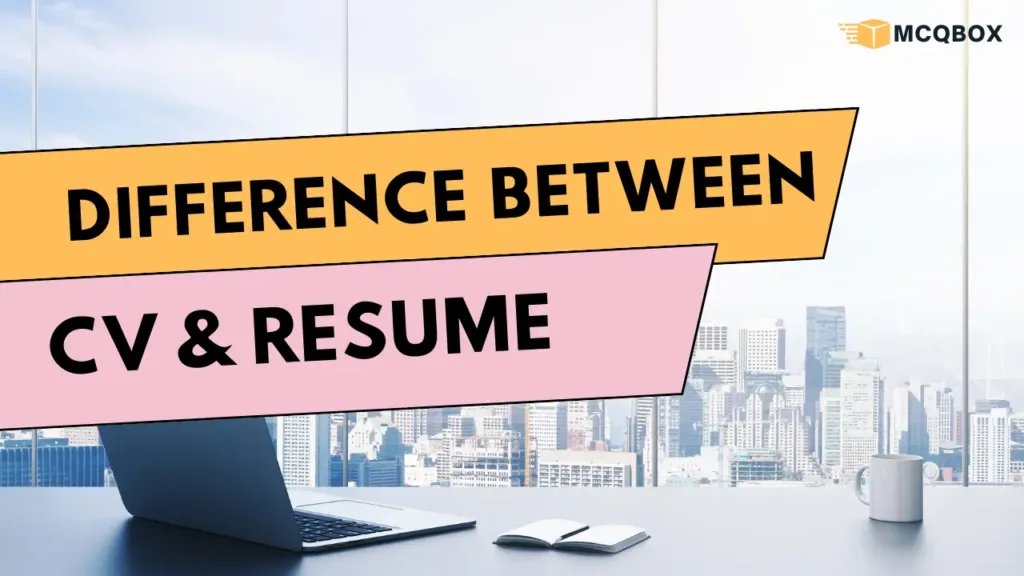Understanding the difference between CV and Resume can help you tailor your job application effectively to showcase your qualifications. A CV is a detailed document outlining your academic and professional accomplishments, while a resume is a concise summary of your skills and experience.
Introduction
In the world of job hunting, you often come across two terms – CV and resume. Let’s break down these papers and see why they matter when you’re on the lookout for a job.
Table of Contents
Difference between CV and Resume

CV vs. Resume: Purpose and Origin
Have you ever wondered what CV means? CV stands for “Curriculum Vitae,” which in simple terms means the story of your life’s journey. On the other hand, “resume” is a French word that means a quick summary. Both these documents are like tailored outfits made for specific jobs, showing why you are the perfect fit.
Dual Applications
Imagine you’re exploring jobs in both academics and industries. This is where CVs and resumes come into play. If you’re aiming for a teaching job or applying for research fellowships, go with a CV. But if you’re eyeing industry jobs, it’s time for the resume to shine. Sometimes, you might need both, especially if you’re juggling both worlds.
CV vs. Resume: Length and Content
CVs and resumes are different in how long they are and what they contain. A CV is like a detailed novel about your academic journey, including publications and presentations. It can be long, covering everything. In contrast, a resume is a short story, usually 1-2 pages, focusing on your skills and qualifications. As you gain more experience, your resume changes, giving more importance to your work experience.
CV and Resume Usage Globally
Imagine you’re applying for a job in Europe, and suddenly everyone is talking about “CVs.” In many European countries, they use “CV” for all job documents. Now, hop over to the U.S. and Canada, where people might use “CV” and “resume” interchangeably. It’s a bit confusing, right? When you’re unsure, just ask for clarification. It’s better to be crystal clear than to submit the wrong document.
Crafting a Resume
Now, let’s get into the details of creating a resume. This is your chance to highlight your skills and say, “Hey, I’m perfect for this job!” Whether you’re aiming for a job in industry, a non-profit, or the public sector, your resume is like your entry ticket. Keep it short, around 2 pages, and change it as you get more experiences. Here are some quick tips to make your resume stand out:
- Customize for the Job: Change your resume for each job. Highlight the skills and experiences that match the job.
- Use Powerful Words: Use strong action words to describe what you’ve achieved. It adds energy to your resume and shows your impact.
- Quantify Achievements: Numbers are powerful. If you can, add numbers to show what you’ve achieved. Instead of saying “Managed a project,” say “Successfully managed a project that led to a 20% increase in efficiency.”
- Change with Experience: After a year or so of working, focus more on your work experience. Put your education section towards the end based on your qualifications.
Crafting a CV
Now, let’s talk about creating a CV. This is your chance to show off your academic achievements, perfect for jobs in academia, fellowships, and grants. It’s like an encyclopedia of your professional life. The length can vary, allowing you to provide a detailed account of your academic contributions. Here are some quick tips to make your CV stand out:
- Start with Education: Your academic journey takes the spotlight. Begin with your education, including the name of your advisor and details about your dissertation if needed.
- Show off Publications: List all your publications, posters, and presentations. This is the place to showcase your scholarly contributions.
- Customize for the Job: Just like a resume, change your CV for each job. Highlight the academic achievements and experiences that make you the perfect fit.
- Consider Length: While a CV can be more extensive, think about the reader’s time. Make it detailed but not overwhelming.
Common Mistakes
Making these documents can be tricky, and you might fall into some common mistakes. Let’s look at some pitfalls and how to avoid them:
Mistakes in Resume Crafting
- Using Generic Templates: Using the same template for every application can make your resume look like everyone else’s. Change it for each job.
- Ignoring Keywords: Many companies use systems to filter resumes. If your resume lacks keywords related to the job, it might not even reach human eyes.
Mistakes in CV Preparation
- Overloading with Information: Yes, a CV is detailed, but bombarding the reader with information can backfire. Be detailed but focused.
- Lack of Focus: Customize your CV for the specific job. Don’t include everything; keep it relevant to the role.